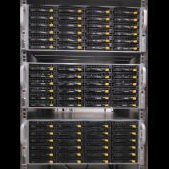Leaderboard
Popular Content
Showing content with the highest reputation on 05/19/22 in all areas
-
OK we figured it out. There was a bug in 6.9.2 that allowed you to use https://servername.local even though it was not valid for the hash.unraid.net certificate the server was configured to use. And since self-signed certificates also throw errors the browser probably didn't make it clear exactly which error you were accepting. So it would have been tough for you to know that the system was misconfigured in 6.9.2. We are going to tweak the upgrade process so that anyone upgrading from 6.9.2 with USE_SSL=auto will change to USE_SSL=yes in 6.10.0. That will eliminate this problem, and put users in control of whether they want the more secure/restrictive USE_SSL=auto setting.4 points
-
Or want to keep an absent minded moment from removing the wrong drive, or have kids, etc. It's a very good idea to keep hot swap drives locked, it's not like they are going to be moved that often, and if they are because you are using one of the bays to do backups that you pull, even more reason to lock the rest of the array drives in place. I'd also consider putting a piece of tape on each bay drive slider with the current last 4 serial on it. Makes life less stressful when a drive fails.2 points
-
2 points
-
I also had a couple of broken containers. I would use WinSCP to go into the folders for those containers in appdata, and see if there are any files that have stricter permissions than other. For example some which are owned by "root" while the others is owned by other users. I don't know why upgrading would break this though.2 points
-
@ich777 Good news, seems like problem was related to my Unraid version as well. Here's what I've done. - Updated Unraid to 6.10.0 - Rebooted - V Rising still experiencing the same issue - Removed the container and deleted appdata directory - Pulled fresh from CA and followed @BennyD's solution by remapping /mnt/cache/ to /mnt/user/ It's now working! Thanks for your help @ich777 & @BennyD2 points
-
-Upgraded ✅ -Cert upgraded ✅ make sure you add to pfsense (Services > DNS Resolver > General Settings > Custom Options) private-domain: "myunraid.net" -if you can't access the GUI after cert upgrade. 1 ssh root@SERVERIP 2 use_ssl no then you can log in using the normal ip way. -Root Shares ✅ -File Manager ✅ Thank you for all the hard work, everything is working GUCCI. Disks are finally sleeping!😴😇🤫2 points
-
FYI: Wer das Plugin "Unassigned Devices" installiert hat und auf das heute erschienene Unraid 6.10 umstellen wird, sollte unbedingt neben den Unraid Update Hinweisen vorab den Beitrag zum Update des Unassigned Devices Plugin lesen. Dies vor allen Dingen wenn man mit NVMe oder SSD Devices im Unassigned Devices Plugin arbeitet - wie ich. Üblicherweise aktualisiert man vor einem Upgrade von Unraid die Plugins und Container. Leider fiel eine kritische Änderung am Unassigned Devices Plugin mit dem Release von Unraid 6.10 zusammen. Beides wurde heute zeitgleich veröffentlicht. Beim Start des aktualisierten Unraid 6.10 können NVMe, SSD Devices durch UD neue Bezeichner erhalten, was unter Umständen Auswirkungen auf die Docker und KVM Subsysteme haben kann. In meinem Fall wurden tatsächlich Unassigned Devices unter neuen Bezeichnern aufgeführt und ich musste das Docker Subsystem neu konfigurieren (Passthru Devices, etc.). Beim KVM Subsystem hatte ich vor einiger Zeit auf "bus:device" statt "dev/by-id" umgestellt. Deshalb wurde ich im Falle von VMs vor notwendigen Änderungen verschont. Ich persönlich finde diesen zeitlichen Zusammenhang für extrem unglücklich. Wer schon etwas tiefer in Unraid eingetaucht ist, der wird das sicherlich schnell beheben können. Wer aber ohne weitere Nachforschung die Update Knöpfe drückt, könnte beim nächsten Start überrascht werden. Also unbedingt lesen.2 points
-
Hi can anyone please tell me how to increase my docker img size without losing anything. I feel like this should be simple but I cannot find a thread anywhere explaining this. Thank you for the help!1 point
-
OP in pre-release section by me for Unraid OS 6.10.0 RC8. Since this issue has persisted into the stable release, I am reposting here. Not sure if allowed to have two posts (prerelease/stable) for the same issue. If this is not allowed, feel free to contact me or adjust as needed. I looked at the full release notes and tried to see if the VNC package that Unraid Linux uses was the cause. I could not figure out which library/package it is. Issue: When editing or creating a VM, the VNC password field in the WebGUI template, does not allow any password greater than 8 characters. This issue was first noticed when turning on a VM just after 6.10.0-RC8 update. I was prompted that my 19 character password exceeded the 8 character limit (as shown similarly in screenshot attached). By today's standards passwords less than 8 characters are considered insecure. Reproduction steps: 1. Inside of Unraid WebGUI, navigate to VMs tab. 2. Select the "ADD VM" button below the list of currently installed VMs to create a new VM. 3. Select VM template type Linux. This shouldn't matter but these are my exact steps for testing. 4. Set primary vDisk size to "10M". 5. Set VNC Password to anything greater than 8 characters. In this case "123456789". 6. Select the button "Create VM". 7. Observe the following error: "VM reation error unsupported configuration: VNC password is 9 characters long, only 8 permitted." everestsrvr-diagnostics-20220518-1203.zip1 point
-
Nothing really made a difference except using a MBR partitioned USB with legacy boot (CSM) turned on in the boot options. GPT partitioned drive I can not get it to work no matter what I put. It either did the exact same thing or I stopped form booting at all which was basically tuning on CSM and setting it Legacy only which I would expect as its GPT and legacy boot doesn't usually work with GPT. I have nothing except for the USB boot drive and an ether net cable connected to it usually. Connected a keyboard and VGA monitor to trouble shoot the booting issue that's it. 6.9.2 works with no changes so some thing has changed in 6.101 point
-
Tried both, no difference. Unraid 6.9.2 boots in usb3 and 2. Like I said, it's not an issue with booting. It boots fine, unraid gets loaded up in ram, it's only when the init steps are happening, unraid somehow thinks the flash drive is not there (likely for license check). There is no issue with actual bios booting1 point
-
1 point
-
woot! Unraid 6.9.2 isn't as picky, but in 6.10.0 the Subject of the cert has to exactly match servername.localTLD. FCP would warn about this so you should be good. Unraid will generate a self-signed cert for servername.localTLD. It does not include the IP in the cert because of complications with IP addresses changing. Plus, it is self-signed so you would have to ignore a browser whether the IP was in the cert or not.1 point
-
1 point
-
I had this same issue. I tried to remove the USB drive and run the "make bootable" bat file and it kept giving me an access denied to MBR error. I was able to work around this by copying all of the contents of my USB drive to my hard drive, zipping it, creating an ISO from the zip file using AnyToISO 3.9.6 Lite Version and then writing that ISO to the USB using RUFUS making sure to name the volume UNRAID. It booted fine after that. Maybe this will help someone else with the same issue.1 point
-
Mover might help if the reason cache can't be written was because it was full, but that isn't the case. Cache is read-only1 point
-
Main issue is with those servers is that updating can corrupt all filesystems, luckily it appears only cache was affected for you, if you have backups it would be best to re-format cache and restore the data, if you don't try to copy everything you can now, it's read only but it's still mounting, so most data should be accessible.1 point
-
1 point
-
You're a champ. Cache mounted and VM running. I'll be able to sleep tonight. THANK YOU VERY MUCH! high fives ;D. If you're ever in Australia look me up, I'll meet up and buy you dinner and a few beers1 point
-
Oh my gawd I love you. It's working! On 6.8.3, I can always update. To stressed to do anymore tonight. I'm going to bed. I'll look at debugging tomorrow. Atleast I can look at log files etc now to see what the problems are? Pete1 point
-
You can do this with cache pool. I think if we need multiple arrays, it's because we need multiple arrays with parity. If we don't need parity, we can do unassigned devices or cache pool. For SSD, the same (as unraid parity is not great with SSD). Multiple arrays allow to reduce the mix of drives like 5x 2TB 5400rpm 2.5" laptop drives and 4x 14TB 7200rpm 3.5" NAS class drives for example, and it allow "turbo write" on theses drives without waking up all the drives1 point
-
You can safely shut it down from the Unraid's Docker tab menu. This will send a SIGTERM to the game server and should end the game server properly. However you could set the Docker Shutdown timeout in the Docker Settings to something higher (like 20 seconds) if you use for example a HDD instead of a SSD in the Docker tab: ...but this shouldn't be necessary anyways, even if you use a HDD. The shutdown works just fine since otherwise the save file from the container that I've installed on my server would be already corrupt (restarted/stopped/started it like 30 times)...1 point
-
@f.lim & @BennyD & @BSAVAG3 I changed the default path in the template now to /mnt/user/appdata/vrising1 point
-
Nothing obvious, make sure you don't have multiple browser windows open on the GUI, also try booting in safe mode.1 point
-
Thank you JorgeB! Physical access to the machine is a bit difficult (no VGA monitor etc) so I can't really disable IOMMU in the BIOS. I've followed the instructions here and set it to `iommu=off` instead of `pt`, as I don't think I need it. I do have a GPU for Plex transcoding, but it's in a docker and not a VM. Parity check is running now so I can't reboot immediately, but I'll report back once it's done. Double thanks for your help -- yesterday your guide here saved me when the cache wouldn't mount.1 point
-
I don't see a diagnostics.zip file, but I'll take a guess... you are trying to use your own custom certificate, but the url on the certificate does not match the servername.localTLD that the server is configured to use. This is causing Unraid to delete your certificate and create a self-signed one that matches Unraid's settings. You have two options, either provide a certificate that matches the server's settings, or change the server's settings to match the certificate you want to use. Take a look here: https://wiki.unraid.net/Manual/Security#Securing_webGui_connections_.28SSL.29 Start with the "A few details before we begin" section so you know how things are defined, then skip down to the "Custom Certificates" section. Probably a good idea to reboot first though to undo any manual edits. If that doesn't help, please provide your diagnostics.zip file (from Tools -> Diagnostics) and tell me what url you want to use to access the server.1 point
-
I too was able to resolve mine my updating to the latest version of Unraid and follow the steps you mentioned. After that it's up and working too.1 point
-
Not to be pedantic, and I do really get where you're coming from (I've posted several times in the thread outlining justifications for this feature above), but changing your servers name, especially on a NAS, is kind of a big deal as it has lots of implications - windows even makes you reboot, for example. Even changing a ports IP address I'd consider to be a less disruptive task, as you could simply be changing one of any number of ports addresses, while the hostname impacts em all across the board.1 point
-
Unraid Pro i7 9700k ASRock Z390 Phantom Gaming-4 CB CB = Custom build, the mobo and cpu came out of a prebuilt gaming computer. 32GB DDR4 2133 MT/s Adaptec ASR 71605 16 Port HBA Quadro P1000 Dual port Gigabit NIC 82575EB chipset, both ports wired to Netgear SXK80 in LAG (NIC not pictured added it after the initial build) Rosewill RSV-L4412U 2x SanDisk Ultra 3d NAND 1TB SSD's for cache (wired to mobo) 1x WD Blue 1TB NVME 2x 12TB Shucked WDC_WD120EDBZ 1x 4 TB Seagate Ironwolf Seasonic FOCUS PX-750 Noctua NH-U12A Noctua fans everywhere, on the HBA too, the stock one was very loud1 point
-
I have this exact problem too. Reverting back to 6.9.2 and everything works from the same USB drive, no format, no change, only moving back old files...1 point
-
Same issue here. Updated from previous stable via gui, rebooted and get the 30 sec message looking for device labeled UNRAID and it can't find it. I tried to manually unzip the bz files and try again, same result. I unzipped the previous stable's bz files and everything's working again. So there are no issues with my flash drive. Perhaps limetech can clarify what that new process is so we can try and figure what the issue is?1 point
-
Upgrade did not go smooth for me. Thankfully I backed up my flash before upgrading. I upgraded through the webgui from the previous stable version. I received an error about waiting 30 seconds for device labeled UNRAID to load and after 30 seconds just rebooted. I ended up having to reflash the usb stick using the official unRaid usb creator and cooy back over my config folder to the flash. I then had to turn off SSL through SSH to be able to get back to the webgui. For some reason PCIe ACS Overide setting was changed to disabled and I had to change that back to downstream to get my Sata HBA and GPU working again. I am on 6.10 now though.1 point
-
Assuming you assigned the drives accurately, yes. You still need to do a parity check to be sure things are synced up, but there should be few if any errors. If you are at all unsure about which drive is parity, don't proceed until you are absolutely positive, as the drive assigned to the parity slot will be overwritten. Drives in the data slots will be left as is.1 point
-
You need to blacklist i915 driver so top can load it correctly or add force probe to syslinux options or modprobe file. echo "blacklist i915" > /boot/config/modprobe.d/i915.conf1 point
-
1 point
-
C'est sûr qu'il faut noter la position en amont pour renseigner le plugin. C'est pas de la magie. Mais c'est plus facile de faire ça proprement au calme quand tout marche bien, comme ça le jour où il y a un soucis et qu'on stresse, on a moins de chance de faire une bêtise. Unraid reconnait les disques avec leur numéro de série, si tu prends bien ton temps et que tu vérifies bien, tu ne devrais pas avoir de problème.1 point
-
Yes, refer to: https://www.openssh.com/txt/release-8.7 Unraid OS 6.9.2 uses openssh version 8.4p1 and Unraid OS 6.10 uses openssh version 8.8p11 point
-
Bonjour. Il y a un plugin pour ça. "Disk location". Il fonctionne très bien. Il te dit les disque que tu as et tu peux les placer en colonne ou en ranger comme dans ton serveur. De plus il a une fonction de faire clignoté les disques sélectionner. Très pratique.1 point
-
Only what's reported can be fixed, once a release goes stable it starts being used by many more users, so a few new issues are expected/inevitable.1 point
-
Very nice work guys. When are we going to be able to ditch using a USB flash drive for unraid, and move over to something more reliable as a boot device? It also makes it a royal pain to virtualise unraid (i know this isn't technically supported)1 point
-
If you google enable gpu acceleration over rdp you will find solutions for discrete gpu by tweaking the windows registry if I remember well..this could work also for the igpu...or not... I know you are now thinking, if you don't know why you reply? I would not consider RDP at all for your use, if you passthrough a gpu/igpu you are enabling hardware acceleration, so your apps/games should use hardware acceleration but rdp will render the screen output and it will send it over the network; this is how rdp works, vnc for example works in a different way. I would consider parsec or any other protocol studied for game streaming and avoid rdp, and obviously with a passed through gpu/igpu.1 point
-
Yes this card should be ready to go. If you are using SSD drives with this you may want to opt for x4 model.1 point
-
It just issues compose pull for now. At the moment this plugin doesn't really have any considerations for the build aspect of compose.1 point
-
The problem that I've always had with backblaze is that they don't quantify what they consider to be a failure, and they use whatever drives they can find cheap in an enterprise environment. Tossing a ST4000DM into an enterprise environment isn't a fair comparison against enterprise drives which are designed for that workload. Somewhat akin to entering a car in the Indy 500 running an engine from a Chevy Cruise vs everything else. Sure, it'll work but it'll also fail pretty fast.1 point
-
adding the below to you mount script should resolve the permissions issue if your updating to 6.10 RC7, i will test in approx 12 hours if this fixes the permissions issue with docker containers and plex. if you run the below from cli it should confirm what USER nobody is set too1 point
-
Hi, So I finally figured it out. It looks like there was an unintentional power loss rebooting my server. For some reason the modprobe i915 setting was not in my 'go' config, not sure why as I am sure I added it on server build last year. However my server had been running 24/7 for over 12 months prior to last week with no reboots. I figured this out by starting the docker from the terminal using 'docker start' command, which complained of no /dev/dri for hardware transcoding. The 'Power Loss' also explains why my main desktop PC stopped posting late last week (lines up with my Unraid uptime and my wife telling me the 'PC is broken it just went off'). I'd just assumed the old z270 board and 6700k had bit the dust with the latter being nearly 6 years old. At least I have a z690 and i12600k now though as a shiny replacement, which I could not have justified before. 😀 Hope this info helps others in the future.1 point
-
You know that since Unraid 6.10.0-rc2 TPM is now available in Unraid and you can Windows 11 as usual. You even can change your VM to use the emulated TPM as long as you are using OVMF as BIOS type without any scripts,...: Click1 point
-
Je profite de ce sujet pour te remercier Superboki pour tes videos.1 point
-
1 point















